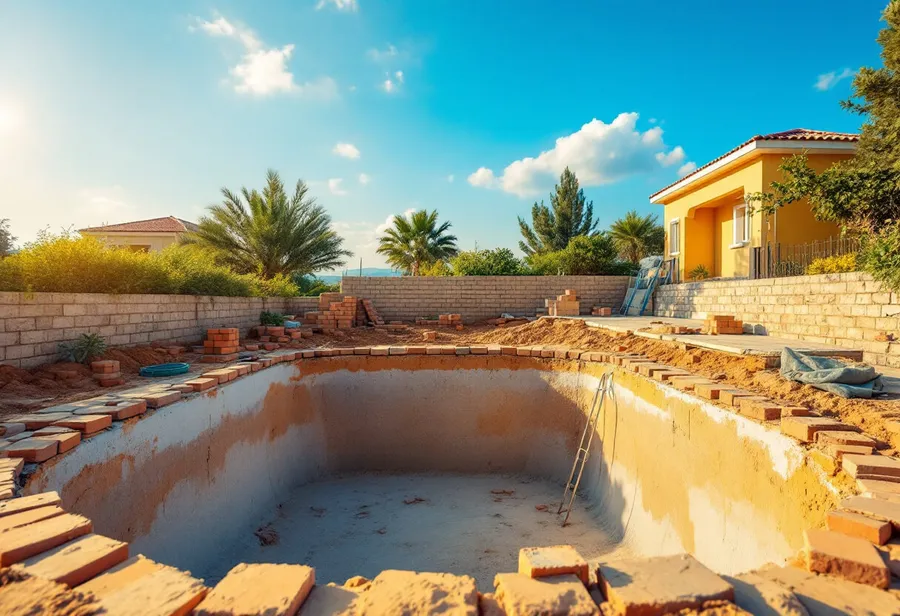Construction planning and scheduling — a complete guide


Introduction
Planning a construction project can seem overwhelming, whether you’re building your dream home, adding a terrace, or renovating your house. This guide will walk you through the essential steps of construction planning and scheduling, making the process manageable and even enjoyable.
1. Why Construction Planning Matters
1.1 Turning Dreams into Reality
Embarking on a construction project is an exciting venture. Whether you’re building a new house or renovating your current home, careful planning is the key to transforming your ideas into a tangible reality.
Clarify Your Vision: Start by picturing what you want to achieve. Do you envision a modern open-plan living space, a cozy terrace for family gatherings, or a complete home renovation to update your house’s style?
Set Clear Goals: Writing down your objectives helps in communicating your ideas to architects and builders. It ensures everyone involved understands your expectations, reducing the likelihood of misunderstandings down the line.
Align Expectations: Early planning helps align your dreams with practical aspects like budget, timelines, and building regulations. This alignment is crucial in preventing disappointments and ensuring a smooth construction process.
1.2 Saving Time and Money
Investing time in thorough planning can lead to significant savings during construction.
Avoiding Costly Mistakes: Without a clear plan, you might face unexpected expenses due to design changes, material shortages, or construction errors. Planning helps identify potential issues before they become expensive problems.
Efficient Resource Allocation: A well-thought-out plan ensures that materials are ordered in the right quantities at the right times, reducing waste and delays.
Time Management: Scheduling allows you to set realistic timelines, coordinate tasks effectively, and keep the project on track. This efficiency minimizes delays that could lead to additional costs.
2. Getting Started with Your Construction Project
2.1 Defining Your Project
The first step in any construction project is to clearly define what you want to achieve.
Identify Your Needs: Consider how you use your space now and how you’d like to use it in the future. Are you looking to accommodate a growing family, create a home office, or enhance your outdoor living area with a new terrace?
Create a Wishlist: Write down all the features you’d like in your project. This list can include the number of rooms, types of materials, energy-efficient installations, or aesthetic styles.
Prioritize Features: Distinguish between “must-haves” and “nice-to-haves.” This prioritization helps in making decisions that align with your budget.
2.2 Setting a Budget
A realistic budget is essential for guiding your project’s scope and ensuring financial preparedness.
Estimate Costs: Research average costs for similar projects in your area. Consider expenses for materials, labor, permits, design fees, and unexpected contingencies.
Include All Expenses: Don’t overlook fees for architects, engineers, and surveyors. Also, factor in costs for landscaping, furnishings, and any temporary accommodations if you’ll need to move out during construction.
Explore Financing Options: Determine how you’ll finance your project. Options may include savings, home equity loans, construction loans, or mortgages. Consult with financial advisors to understand what works best for your situation.
Build a Contingency Fund: Set aside an additional 10-20% of your budget for unforeseen expenses. Construction projects often encounter surprises, and having a buffer prevents stress and financial strain.
3. Finding the Right Construction Company
3.1 Why Hire Professionals
Partnering with a reputable construction company is crucial for the success of your project.
Expertise and Experience: Professional builders bring technical knowledge and practical experience. They understand the complexities of construction, from structural integrity to building codes.
Quality Craftsmanship: Skilled professionals ensure that the work is done correctly and to high standards, which is vital for the longevity and safety of your home.
Project Management: A good construction company coordinates all aspects of the build, including scheduling subcontractors, ordering materials, and managing timelines.
Legal Compliance: Professionals are familiar with local regulations and permit requirements, reducing the risk of legal issues that could delay your project.

3.2 Choosing a Construction Company
Selecting the right builder requires careful consideration.
Research Local Builders: Start by compiling a list of construction companies in your area. Look for those specializing in your type of project, whether it’s new builds, home renovations, or terrace additions.
Check Credentials: Verify that the company is licensed, insured, and bonded. This protection ensures they meet professional standards and provides coverage in case of accidents or disputes.
Read Reviews and Ask for References: Online reviews and testimonials offer insights into past clients’ experiences. Don’t hesitate to ask the company for references and follow up with those individuals.
Review Past Projects: Examine their portfolio to assess the quality of their work and see if their style matches your vision.
Conduct Interviews: Meet with potential builders to discuss your project. Prepare questions about their process, timelines, how they handle challenges, and their communication approach.
Compare Quotes: Obtain detailed estimates from multiple companies, but remember that the lowest price isn’t always the best choice. Consider the value offered, including experience, quality, and reliability.
Wheter you have a clear vision or need guidance to bring your ideas to life, Buildify is here to help. Let’s collaborate to create something extraordinary.
4. Designing Your Dream Space
4.1 Collaborating with Architects and Designers
Working with design professionals brings your ideas to life in detailed plans.
Initial Consultations: Share your wishlist and project goals with your architect or designer. They can offer creative solutions and suggest features you might not have considered.
Understanding the Process: Designers will develop sketches, then detailed drawings, and finally construction documents. These plans are essential for obtaining permits and guiding the builders.
Balancing Aesthetics and Functionality: Professionals ensure your space is beautiful and serves your practical needs. They consider traffic flow, natural light, and how different areas interact.
Material Selection: Architects and designers can recommend materials that fit your style and budget, from sustainable flooring options to innovative fixtures.
4.2 Planning for the Future
Consider how your needs might change over time.
Sustainable Design: Incorporate eco-friendly practices, such as energy-efficient windows, insulation, and renewable energy sources like solar panels. Sustainable homes are not only better for the environment but can also reduce long-term operating costs.
Universal Design Principles: Designing with accessibility in mind ensures your home remains comfortable as you age. Features like step-free entrances, wider doorways, and grab bars can be both functional and stylish.
Flexible Spaces: Create rooms that can serve multiple purposes. A home office might double as a guest room, or an open-plan living area can adapt to different lifestyle needs.
Technology Integration: Plan for smart home features like automated lighting, security systems, and climate control. Pre-wiring for technology during construction is often easier and more cost-effective.
5. Navigating Permits and Regulations
5.1 Understanding Local Building Codes
Before breaking ground on your construction project, it’s essential to become familiar with the local building codes and regulations in your area.
Why They Matter: Building codes are designed to ensure the safety, health, and welfare of occupants. They set minimum standards for construction, covering aspects like structural integrity, fire safety, energy efficiency, and accessibility.
Avoiding Legal Issues: Non-compliance can lead to fines, delays, or even the need to redo work. In extreme cases, authorities may halt your project entirely.
Common Regulations in Cyprus: In Cyprus, building regulations are governed by municipal authorities and must comply with national laws. These regulations may include restrictions on building heights, distances from property boundaries, and specific architectural styles in certain areas.
5.2 The Permit Application Process
Securing the necessary permits is a critical step that should be integrated into your project timeline.
Documentation Needed:
- Architectural Plans: Detailed drawings of the proposed construction.
- Structural Calculations: Engineering assessments to ensure safety.
- Environmental Assessments (if required): For projects impacting the surrounding environment.
Application Submission:
- Municipal Offices: Permits are usually obtained from your local town hall or district administration.
- Accuracy Matters: Ensure all forms are filled out correctly to prevent delays.
- Professional Assistance: Your architect or construction company can help prepare and submit the necessary documents.
Timeline Expectations:
- Approval Process: It can take from a few weeks to several months, depending on the complexity of your project and the efficiency of the local authority.
- Plan Accordingly: Factor this into your overall project schedule to avoid unexpected delays.
Inspections During Construction:
- Scheduled Checks: Authorities may require inspections at various stages.
- Compliance Verification: These ensure the work meets code requirements.
- Documentation: Keep records of all inspections and approvals.
Fees and Costs:
- Permit Fees: Be prepared for application costs, which should be included in your budget.
- Potential Additional Costs: If changes are required by the authorities, there may be extra expenses.
6. Creating a Construction Schedule
6.1 Breaking Down the Project Phases
Having a clear construction schedule helps manage expectations and keeps the project moving efficiently.
Pre-Construction Tasks:
- Site Preparation:
- Clearing the land and removing any existing structures.
- Setting up necessary utilities and access roads.
- Foundation Work:
- Excavation and laying the foundation, which is critical for structural integrity.
- Site Preparation:
Construction Milestones:
- Framing:
- Building the skeleton of the house, including walls, floors, and roof structures.
- Installing Systems:
- Electrical wiring, plumbing, heating, and cooling systems.
- Integration of smart home technology if desired.
- Insulation and Drywall:
- Ensuring energy efficiency and soundproofing.
- Creating the interior walls that define your spaces.
- Interior Finishes:
- Installing flooring, cabinetry, countertops, and fixtures.
- Painting and decorating according to your design.
- Exterior Finishes:
- Applying siding, roofing materials, windows, and doors.
- Adding features like terraces, balconies, or verandas.
- Landscaping:
- Designing outdoor spaces, gardens, driveways, and walkways.
- Planting trees, shrubs, and installing irrigation systems.
- Framing:
6.2 Setting Realistic Timelines
Time management is crucial in construction to ensure the project is completed efficiently.
Factors Affecting Duration:
- Weather Conditions:
- In Cyprus, the climate is generally favorable, but consider seasonal rains or extreme heat.
- Material Availability:
- Special orders or imported materials may have longer lead times.
- Labor Scheduling:
- Coordinating skilled workers and subcontractors effectively.
- Weather Conditions:
Buffer Times:
- Expect the Unexpected:
- Allocate extra time for potential delays like supplier issues or unexpected site conditions.
- Flexibility:
- A flexible schedule can adapt to changes without causing significant setbacks.
- Expect the Unexpected:
6.3 Staying on Track
Regular monitoring and communication are key to keeping your project on schedule.
Regular Updates:
- Weekly Meetings:
- Schedule consistent check-ins with your construction team.
- Progress Reports:
- Request detailed updates on completed tasks and upcoming milestones.
- Weekly Meetings:
Adjusting the Schedule:
- Responsive Planning:
- Be prepared to make decisions quickly when unexpected issues arise.
- Document Changes:
- Keep a record of any adjustments to the timeline for transparency.
- Responsive Planning:
Communication Tools:
- Project Management Software:
- Some companies offer online portals where you can track progress.
- Visual Aids:
- Gantt charts or similar tools can help visualize the schedule.
- Project Management Software:
7. Tips for a Smooth Home Renovation
7.1 Living Through Renovations
Renovating your home while living in it presents unique challenges.
Planning Around Your Routine:
- Phased Renovations:
- Tackle one area at a time to minimize disruptions.
- Plan renovations during times when it least impacts your daily life.
- Temporary Living Spaces:
- Set up alternative spaces for cooking, bathing, or sleeping if necessary.
- Phased Renovations:
Safety Considerations:
- Secure Construction Zones:
- Clearly mark off work areas to prevent accidents.
- Dust and Debris Management:
- Use barriers and coverings to limit the spread of dust.
- Noise Control:
- Communicate with your contractor about work hours and noise levels.
- Secure Construction Zones:
7.2 Preservation vs. Modernization
Balancing the charm of your existing home with modern updates can enhance both its value and livability.
Blending Old and New:
- Architectural Harmony:
- Retain original features like moldings, fireplaces, or exposed beams.
- Complementary Materials:
- Select new materials that match or enhance existing textures and colors.
- Architectural Harmony:
Incremental Renovations:
- Prioritize Needs:
- Address essential repairs before aesthetic changes.
- Budget Management:
- Spreading out the work can make renovations more affordable.
- Prioritize Needs:
Consulting Specialists:
- Historic Preservation Experts:
- They can provide guidance on maintaining the integrity of older structures.
- Energy Efficiency Upgrades:
- Install modern insulation, windows, and heating systems without altering your home’s character.
- Historic Preservation Experts:
8. Budgeting and Managing Costs
8.1 Understanding Cost Drivers
Knowledge of what influences costs can help you make informed decisions and keep your budget in check.
Material Choices:
- Quality vs. Cost:
- Higher-quality materials may cost more upfront but can save money over time due to durability.
- Sustainable Materials:
- Eco-friendly options might have higher initial costs but offer long-term savings through efficiency.
- Quality vs. Cost:
Labor Expenses:
- Skilled vs. Unskilled Labor:
- Investing in skilled workers can result in better craftsmanship and fewer mistakes.
- Labor Rates:
- Understand how labor costs are calculated and what they include.
- Skilled vs. Unskilled Labor:
8.2 Contingency Planning
A well-prepared budget includes provisions for unexpected costs.
Setting Aside Reserves:
- Recommended Contingency Fund:
- Allocate an extra 10-20% of your budget for surprises.
- Peace of Mind:
- A contingency fund reduces stress by preparing for the unexpected.
- Recommended Contingency Fund:
Common Unexpected Expenses:
- Unforeseen Structural Issues:
- Discovering problems like water damage or faulty wiring.
- Upgrades and Changes:
- Deciding to select higher-end finishes or additional features mid-project.
- Unforeseen Structural Issues:
Negotiating with Contractors:
- Transparent Contracts:
- Ensure all costs are clearly outlined in your agreement.
- Payment Terms:
- Understand the schedule of payments and what each installment covers.
- Transparent Contracts:
Regular Financial Updates:
- Tracking Expenses:
- Keep a close eye on expenditures versus the budget.
- Open Communication:
- Discuss any cost overruns immediately with your contractor.
- Tracking Expenses:
9. Quality Control and Final Touches
9.1 Regular Site Visits
Even with a reliable construction company, your involvement is crucial to ensure the project meets your expectations.
Staying Involved:
- Scheduled Walkthroughs:
- Arrange regular visits to the construction site with your contractor.
- Use these opportunities to observe progress and discuss any concerns.
- Open Communication:
- Keep a dialogue with your construction team to stay informed about developments.
- Promptly address any questions or issues that arise.
- Scheduled Walkthroughs:
What to Look For:
- Quality of Workmanship:
- Examine the finishes, fittings, and overall quality of the construction.
- Ensure that materials and installations match what was agreed upon.
- Consistency with Plans:
- Verify that the work aligns with architectural drawings and specifications.
- Note any deviations and discuss them with your contractor.
- Quality of Workmanship:
9.2 The Final Walkthrough
Before signing off on the project, conduct a thorough inspection to ensure everything is completed to your satisfaction.
Creating a Punch List:
- Identify Issues:
- Make a detailed list of any defects, incomplete work, or items that need adjustment.
- Check all areas, including hard-to-reach places, for any overlooked details.
- Collaborate with Your Contractor:
- Review the punch list together and agree on a timeline for addressing each item.
- Maintain a cooperative approach to ensure swift resolution.
- Identify Issues:
Warranty and Maintenance:
- Understanding Guarantees:
- Familiarize yourself with any warranties on workmanship and materials.
- Know the duration and coverage to protect your investment.
- Maintenance Tips:
- Ask for guidance on caring for new installations and materials.
- Obtain manuals or instructions for appliances and systems.
- Understanding Guarantees:
Final Documentation:
- Collect Certificates:
- Ensure you receive all necessary completion certificates and compliance documents.
- Organize Records:
- Keep all contracts, receipts, warranties, and manuals in a safe place for future reference.
- Collect Certificates:
Final Payments:
- Adhere to Agreements:
- Release final payments as per your contract, once all work is satisfactorily completed.
- Ensure any changes or additions are documented and settled.
- Adhere to Agreements:
10. Celebrating Your New Space
10.1 Moving In
With construction complete, it’s time to transition into your new or renovated home and start making memories.
Preparing for the Move:
- Deep Cleaning:
- Schedule a thorough cleaning to remove any residual dust or debris.
- Clean air ducts and filters to ensure good air quality.
- Utility Setup:
- Confirm that all utilities are connected and functioning properly.
- Test heating, cooling, electrical systems, and appliances.
- Deep Cleaning:
Organizing the Move:
- Packing and Unpacking:
- Label boxes clearly to make unpacking easier.
- Prioritize essential items to settle in comfortably.
- Furniture Placement:
- Plan where your furniture will go in advance.
- Consider the flow of spaces and functionality.
- Packing and Unpacking:
10.2 Enjoying the Fruits of Your Planning
Take the time to appreciate your accomplishment and the new environment you’ve created.
Reflecting on the Journey:
- Satisfaction in Achievement:
- Recognize the effort and dedication invested in the project.
- Enjoy the improved comfort, aesthetics, and functionality of your space.
- Sharing with Loved Ones:
- Invite friends and family to experience your new home.
- Hosting a housewarming can be a gratifying way to celebrate.
- Satisfaction in Achievement:
Making the Most of Your New Space:
- Creating Memories:
- Embrace new routines and traditions in your improved surroundings.
- Enjoy activities like cooking in your new kitchen or relaxing on your terrace.
- Community Engagement:
- Get to know your neighbors if you’re in a new area.
- Explore local amenities or attractions.
- Creating Memories:
Looking Ahead:
- Maintenance Planning:
- Schedule regular maintenance to keep your home in top condition.
- Stay proactive to prevent minor issues from becoming major repairs.
- Future Projects:
- Consider any additional enhancements or landscaping to further personalize your home.
- Maintenance Planning:
Conclusion
Embarking on a construction or renovation project is a significant endeavor that requires careful planning, coordination, and collaboration. By following this comprehensive guide, you’ve learned how to navigate each stage—from initial planning and budgeting to selecting the right professionals, understanding permits, and overseeing construction.
Your dedication to thoughtful planning and active involvement has set the foundation for a successful project. As you settle into your new or improved space, you can take pride in the comfortable, functional, and beautiful environment you’ve created—a place that truly feels like home.
Remember, the journey doesn’t end here. Homeownership is an ongoing experience, and maintaining your property will ensure it remains a source of joy and satisfaction for years to come.
Whether you have a clear vision or need guidance to bring your ideas to life, Buildify is here to help. Let's collaborate to create something extraordinary.


